
This account by Les Donnithorne, a Mitchell man, was discovered after his death. It is the recollections of someone whose only motivation was to record the history of his village. His son, also Les, was determined that his father’s story should be made public and joined with Cornish historian, Tony Mansell, to publish it here, in Cornish Story.
“It is now 2011 and I am 85 years old so I decided to sit and write as much as I could remember about Mitchell”. (Les Donnithorne)
My memories from when I was four-and-a-half
I was born at South Nancemeer Farm on the 17th March 1926 – St Patrick’s Day. My father was Harry Donnithorne, my mother was Mabel (née Tozer) and I had an elder brother called William who was always known as Billy Donn.
 Mabel Donnithorne (née Tozer) – my mother
Mabel Donnithorne (née Tozer) – my mother
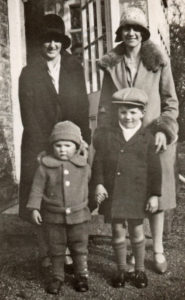 Circa 1928: my mother, Mabel, auntie May, me (left) and Bill
Circa 1928: my mother, Mabel, auntie May, me (left) and Bill
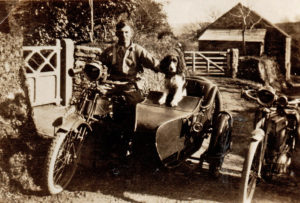 Harry, my father, on his motorbike and sidecar
Harry, my father, on his motorbike and sidecar
 Harry with sons William (left) and Les (me)
Harry with sons William (left) and Les (me)
I began attending Mitchell School in 1931 when I was four-and-a-half years old. Our teacher was Miss Turner, the only teacher for all the pupils – from infants to school leavers. It was then decided that the school should be limited to the younger age group with the older children transferring to elsewhere. My brother Bill, being three years older than me, was one of those who had to move. Most moved to Summercourt School but as we lived just outside the village, my brother had to go to St Newlyn East school and although I was in a younger age group, it was decided that I may as well go with him.
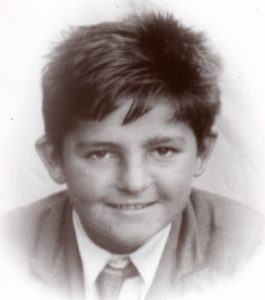 Les Donnithorne (me)
Les Donnithorne (me)
We had to walk from South Nancemeer Farm to St Newlyn East School in all winds and weathers but sometimes we would be lucky and we managed to receive a lift on a passing oss-n-cart. It was a long walk for us and the children attending Summercourt School, with transport provided, would be back at home while we were still only halfway. Because of this, we had little contact with the village children in the evenings but did go to Mitchell Sunday School.
My story that follows is a mixture of what I was told about Mitchell as I was growing up and what I remember. To the best of my knowledge it is correct but some of the information has been handed down through the generations and the detail may have become distorted. However, this is as I understand it to be.
An introduction to Mitchell
Mitchell was variously known as Villa Mychell, Medershole, Modishole, Michell and St Michaels. It was once on the main A30 trunk road, the old highway through Cornwall, and is partly in St Enoder Parish and partly in the Parish of St Newlyn East. I believe that some people have already recorded the history of Mitchell fair and its market which started way back in the 1200s.
In 1239, during the reign of Edward I, Walter de Raleigh (Lord of the Manor of Degembris) and his wife, Isobel, obtained a royal charter for an annual fair on St Francis Day and a weekly market at Miedeshol (Mitchell). At this time, Mitchell was an appendage to the Manor of Degembris.
Peter de Raleigh subsequently split the manor and sold Mitchell to Sir Reynfry Arundell. John Arundell declared his right to hold a market and fair in his manor as it was already granted to his predecessor. This fair was an annual event and remained so until the outbreak of the Second World War – I can still remember the fair being held.
Mitchell remained in the ownership of the Arundells for several centuries before being sold to a family named Scaw and then to Sir Christopher Hawkins of Trewithan. He owned it until the nineteenth century.
In 1546 it had achieved parliamentary representation but became one of the infamous Rotten Boroughs. The franchise in Mitchell was also a matter of controversy in the 17th century but was settled by a House of Commons resolution on 20th March 1700 which stated, “The right of election of members to serve in Parliament for the Borough of St Michael’s, in the County of Cornwall, is in the portreeves, and lords of the manor, who are capable of being portreeves, and the inhabitants of the said borough paying Scot and lot”. (Scot and lot is a phrase common in the records of English medieval boroughs, applied to householders who were assessed for a tax paid to the borough for local or national purposes. They were usually members of a merchant guild. Before the Reform Act 1832, those who paid scot and bore lot were often entitled to the franchise.)
Sir Walter Raleigh represented Mitchell in Parliament in 1593 and, in 1807, the Honourable Sir Arthur Wellesley, the first Duke of Wellington, was its member of parliament. There are still houses in the village which carry their names.
Two other famous names who visited Cornwall were the great Methodists John and Charles Wesley who came to Mitchell in the 18th century to preach the Gospel.
The Area around Mitchell
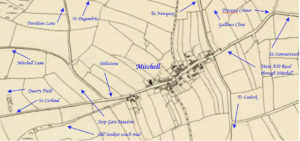
Mitchell Lane
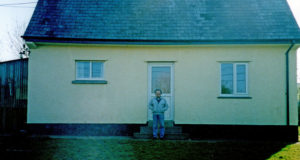 Circa 2005: Me at South Nancemeer Farm (later West Nancemeer Farm) where I was born
Circa 2005: Me at South Nancemeer Farm (later West Nancemeer Farm) where I was born
South Nancemeer Farm is about a half a mile along Mitchell Lane, the Newlyn East Road. Rose River is about a quarter of a mile beyond our farm and from there back to where it joined Carland Hill was known as Mitchell Lane. At that junction with the main A30 road was a triangular piece of land with a signpost pointing to St Newlyn East, Truro and Bodmin. We had a field there called Stop Gate Meadow, it was surrounded by huge elm trees and it had apparently once been the location of a toll gate.
My mother’s parents, sister and brothers lived in Crantock and we visited then using my father’s pony and trap. Sometimes we would visit my other grandfather at Trevilson Farm which was just across the fields from us.
We often saw a chap called Billy Le Min who used to walk from Nancemeer to the Mitchell and Newlyn Railway Halt to catch the train to work at Newquay. Sometimes he walked through Trevilson using the lane to Lappa or sometimes we used to see him when we were walking to St Newlyn East School, going out to Mitchell Lane and towards East Wheal Rose.
Today, in 2011, as I recall and write these notes, South Nancemeer Farm has been re-named West Nancemeer Farm.
Goonwinnow Farm, off Mitchell Lane was across the valley from Trevilson. The Trethewey family farmed there many years ago and I was told it was Mr Trethewey who installed the water wheel and dug the mill race, a leat, to the mill pond which was operated by the water from Rose River. In recent years, the wheel has been restored but the mill race has been levelled and is gone.
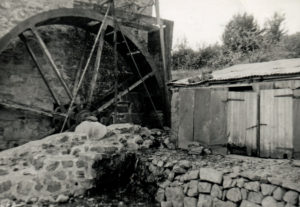 Goonwinnow Farm waterwheel
Goonwinnow Farm waterwheel
I remember the Huthnance family coming to Goonwinnow Farm from Kehelland. Their youngest son, Ken, was a year older than me and we became good friends and spent many hours together. I can mind the water wheel working – crushing corn and driving the winnowing machine. I am probably the only person still alive in the parish who has sailed across Goonwinnow Millpond in an old wooden bathtub. My brother, Bill, fell in once and when Ken and I pulled him out we took him to a wooden, summer chalet in the field between the Millpond and the Newlyn Road. He took off his wet pullover and placed it on the veranda railings before deciding that we had better go over to our Gran’s at Trevilson. We went by a footpath below Goonwinnow Farm, followed the hedge through the marshy bottoms, over a wooden bridge and then along the hedge to Trevilson. I don’t think it was a public footpath but what was referred to as a Postman’s Way. A couple of days later Ken and I went to the chalet and found some honeybees flying around. They were going in and out through a gap in the wall planks at the back of the chalet and Ken decided to do something about them. He took my brother’s pullover from the rail and started to drive them out. Next minute, a swarm attacked him. He ran home across the field with the bees about his head. He managed to get indoors and his auntie fetched the bluing bags and cut onions to treat the stings. Funnily enough I was not stung at all.
Bill, Ken and I would often wander from Goonwinnow, up to Carland, across to Black Hill Quarry, back to Carland and down through the old mines. None of the mineshafts were capped back then. We had our fun throwing large stones down them and hearing the bangs and knocks echoing as they went down the shafts.
The Huthnance family attended Mitchell Chapel. Mr Huthnance was a lay preacher and one of the many farming families who used Mitchell for most things. When they moved to East Wheal Rose Farm they kept in contact with the Mitchell community with Mr Huthnance joining Mitchell Home Guard Platoon when the Second World War started.
When the Huthnance family left Goonwinnow Farm, the Harris family moved to there from Mithian. Mr Harris was originally from Cubert and knew my parent’s families. He was a carpenter having learnt his trade with Mr McCoskrie at Grampound Road. Angus McCoskrie married my father’s sister, Amy, and they moved to America.
Trevilson Lane
Grove Cottage was the first farm on the right on Trevilson Lane but no trace of it now exists. The Jolly family were the last to farm it, I believe. A new farm has been built there and it is now, confusingly, called South Nancemeer. I think the first family to move into the new farm was George Osborne and his wife Esther sometime in the middle 1940’s, I cannot be sure because I was not in Mitchell at that time. They had five children: Rex, Tony, Gillian, Jack and Wendy. In 1965 Dave Leggo and his wife Joan moved up from down West and took over the farm, Dave is still farming there now and only a few years ago I had great fun looking for his Trailer pin lost in the mud with my metal detector.
Just past the new South Nancemeer Farm was a lane leading to Nancemeer (I have also seen it spelt Nancemear and Nance Mere but I am sticking with Nancemeer). At the top of the lane, a sign pointed to Le Mere, and to the right, East Nancemeer (an 1813 map shows Nancemeer where East Nancemeer is now and a 1951 map shows Nancemeer where Le Mere is). The 1983 map shows Le Mere and East Nancemeer where they are today. Confused or not, but I always remember Nancemeer to be on the right, a very old farmhouse, thatched I think. In the 1930s a family called Clark lived at Le Mere but I understand it was demolished many years ago.
Further along Trevilson Lane was Trevilson itself. There were three families living there: the Sparkes who lived in the cottage, the Trembaths who had the small farm, and my grandparents, Henry and Annie Donnithorne who lived in Trevilson Farmhouse with their two daughters Amy and May. Mr Trembath was a lay preacher who came to Mitchell Chapel to preach. My grandparents attended Newlyn Chapel and having already walked to Newlyn School five times a week, Bill and I had to walk to there again when we attended chapel with them. I can recall members of the Lobb family from Summercourt also visiting Newlyn on a Sunday: he was a schoolteacher, I think. He had a car with what was called a Dickie seat, an open seat at the back, and sometimes we would get a lift home.
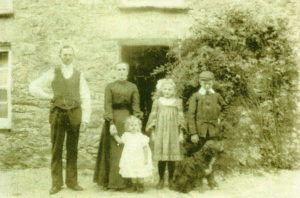 Trevilson Farm circa 1904: Henry and Annie Donnithorne with their children: Amy, May and Harry (my father)
Trevilson Farm circa 1904: Henry and Annie Donnithorne with their children: Amy, May and Harry (my father)
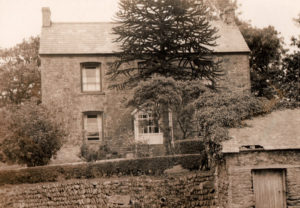 Trevilson Farm circa 1920s/30s
Trevilson Farm circa 1920s/30s
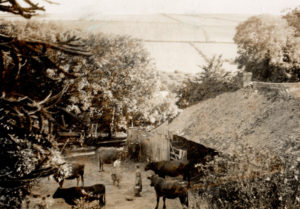 Trevilson Farm circa 1920s/30s
Trevilson Farm circa 1920s/30s
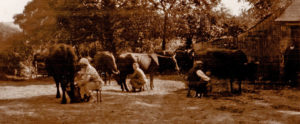 Milking time with sisters May and Annie with their father, Henry
Milking time with sisters May and Annie with their father, Henry
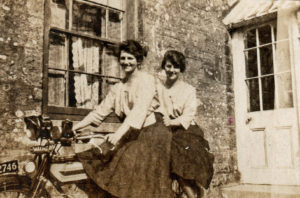 Harry’s sisters, Amy and May, on his motorbike
Harry’s sisters, Amy and May, on his motorbike
My grandfather retired from Trevilson Farm in 1939 and I believe it was Jack Spear who then farmed there.
The names of Mitchell Lane and Trevilson Lane are long gone and forgotten. No trace of the junction of the old Carland Hill can be found – it is now buried under the supports for the new A30 bypass bridge.
Carland
Where Mitchell Lane re-joined the old A30 road, at Stop Gate Meadow, we turned right to go up Carland Hill. The field on the right was Quarry Field but the old workings have been filled in.
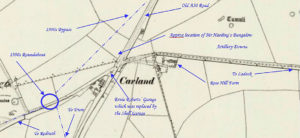
Carland garage was run by Ernie Roberts. Sam Roberts and his family lived in one of the cottages there, Mr Ferris and his family lived in another and Bob Hambley in the last one. These cottages were in St Erme Parish as was Rose Hill Farm on the road to Truro. The Roberts were brothers and Tom Lock worked with them in the garage. He lodged with Mrs Roberts in Mitchell. Her husband, a brother to Ernie and Sam, was killed in the First World War. Tom Lock had a brother who drowned in Black Hill Quarry. I was told that Sam Roberts fetched some waggon rope and stood on one side of the quarry with my father on the other. They managed to dredge up the body which was taken away on an oss-n-cart.
In the early 1930s a family called Keast lived in Carland and their son, Lionel, went to Mitchell School at the same time as me. He was older than me and later married a distant cousin of mine.
There was a waggon house by the side of the A30 at the top of Carland Hill, it was a stopping place for the inspectors who travelled from the Truro Workhouse to St Columb Workhouse. One attempted to commit suicide in the waggon house using a knife and I seem to recall that one hanged himself in John James’ cowshed.
Just west of Carland was Warren’s Barrow which was in St Erme Parish and on the left was a path which led down across the fields to the road from Mitchell to St Newlyn East: it was regularly used by local people back then. A track led down from the barrow towards South Cargoll Mines, down past Wheal Constance – better known as Out Barbary’s – and joined up with a track from East Wheal Rose to Shepherds. I have travelled this track many a time on my bike but now it is almost gone. Old timers used to say that years ago the drovers brought their cattle as far as Carland on a Friday or Saturday, quartered and rested them there until early Monday morning, then drove them on to St Columb Major Market (it is interesting to see that on the 1831 map, Carland is called Cowland). During the 1930s the Four Burrow Hunt used this part of Newlyn Parish for their point-to-point meetings.
Just as you started along the Ladock road was Rose Hill Farm, to where the Delbridge family moved from Trevessa.
Carland had some 18 or more barrows that I can remember from when I was a lad: at least five or maybe six are in the St Newlyn East Parish. These were to the north of the Carland to Ladock road but only one now remains, the rest have been ploughed over. The field next to where the radio mast is located was called Artillery Downs. In the west end of the meadow which John James Morcomb used, was a parish boundary stone but the last time I walked that way it had disappeared. Sydney Harding, who farmed Trevessa, retired and built a bungalow in this meadow in about 1938. This was the only dwelling at Carland which was in St Newlyn East Parish. Sydney Harding’s cottage, along with Ernie Roberts’ garage, had to go to make way for the new bypass road and roundabout at Carland in 1991 and the Shell garage was built to accommodate motorists following the loss of Ernie’s garage.
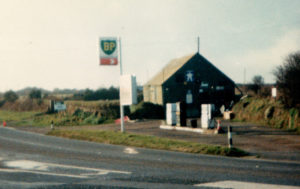 Ernie Roberts’ garage at Carland
Ernie Roberts’ garage at Carland
 Mr Harding’s bungalow
Mr Harding’s bungalow
 The Shell garage
The Shell garage
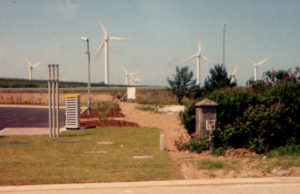 The windmills at Carland
The windmills at Carland
Soon after the start of the 1939 war, Spanish soldiers who were a part of the British Army, built roadblocks, anti-tank obstacles and a pill box at Carland. The pill box was made to look like a house and was on the corner of the Ladock road and the old Truro Road. Now it’s all gone and forgotten.
Ladock Road
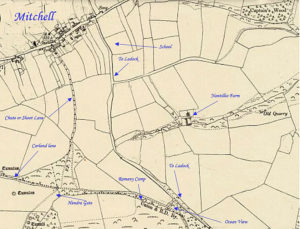
You will see later that there is a public footpath, Chute or Shoot Lane, from the Plume of Feathers to Hendra Gate. Further down this lane, beyond Hendra Gate, is Hendra Farm which was run by a Mr Guest who moved down to Staple Tenement in the village when the Jelbert family moved into Hendra Farm. Mr Jelbert, for some reason I do not know, was called Cap’n Jim. After that, Morris Nicholas rented the farm. He married Muriel Hawke the daughter of Stanley Hawke from Mitchell. The lane continues to Trewaters and to the main road to Truro which was in St Erme Parish. Before the change of parish boundaries, the section of path that crossed the three-cornered patch of Mitchell Downs would have been in St Enoder Parish. Edward Ned Collins lived there. He had a vegetable garden, apple trees and a fowl run. He built a wooden shed and a dugout shelter in the bank by the lane as a stable for his cob horse Shoty. He sold firewood in Newlyn from his light, four-wheeled waggon. He had relatives in Mine Lane at Newlyn and I think his descendants may well farm Park Noweth at Newlyn. He was also an expert stone hedger and there are still a few of us who refer to the place where he lived as Ned’s Bottoms.
On the wide verge of grass leading along from Hendra Gate towards Ladock, on the three-cornered piece of downs, were several Romany families living in their horse-drawn caravans. Although these families were quite friendly, they did keep to themselves. They had some very good ponies and made and sold clothes pegs. You would hear them talking to one another in their own language. Not long after the Second World War began a stray German bomb dropped in a field not far from the road and all but one of the Romany families moved out. That one family remained for a few years but the others never returned.
A little further on, where the Carland road met the Mitchell to Ladock road, was where Simon Rose lived in a bungalow called Ocean View: he once had a bit of a blacksmith shop in Mitchell I believe. Back in the early 1900s he had a fleet of three steam threshing machines and by 1930 he had two farms, Ocean View and Landrine Farm in Ladock Parish. Close to Ocean View lived Jim Roberts and his family in a Romany Caravan, he had a scrap car business. He later moved from there, sometime in the late 1930s, to a bungalow he had built on Trevilson Lane: he was often referred to as Gentleman Jim.
Dick Instance lived in a caravan on the east side of the Ladock road, near Ocean View. He was always called Iron Dick because, I believe, he dealt in scrap metal during the 1914-1918 war. He later moved his caravan over to Hendra Gate, just inside the field but all Hendra belonged to Cap’n Jim. Ned Collins became a bit concerned, fearing that if Iron Dick stayed there he would be forced out. Late one evening he put a white sheet over himself and his cob horse, went up to Iron Dicks’ caravan and rode his cob around it. Now, it is possible that Iron Dick had visited the Plume of Feathers earlier that night but the story goes that he had seen a ghost horse and rider. Just after that he took his family to Newlyn to live, he would not stay at Hendra Gate.
Taking the road to the left and we are heading back towards the village and on the right is Nantillio Lane which led to Nantillio Farm. The Dungey family farmed this until they moved to Cury, down west; another member of the Jelbert family now farms here. Nantillio Field on the right, at the start of the lane to the farm, has been used for all sorts of events and activities from the 1960s onwards: grass track meeting, clay pigeon shoots, football, cricket and sheaf pitching. Continuing along this road the area was called Hunger Hills. There used to be a big shed here which was a regular nesting place for barn owls – it is no longer there. Further on, down through the valley was Cap’n Jim’s wood commonly called Captain’s Wood and further up the valley was Arrallas Farm, a very old place. At one time, the Williams family farmed Arrallas before moving to Lanarth near St Keverne, way down west. Later Cap’n Jim Jelbert moved from Hendra Farm to here. All the Jelbert family were great Methodists and supporters of Mitchell Methodist Chapel. In the same area, towards Ladock, were Trelasick Farm and Boswiddle Farm. The Trebilcocks farmed Trelasick before moving to Ivy House in Mitchell. Jim Hawkin from Degembris Minor, now known as Degembris Cottage, just north of Trevilson, moved in when Mr Trebilcock vacated the farm.
The Summercourt Road
Returning to the village we come to the crossroads where you can turn left and make your way through the village, go straight on for Newquay or turn right for Summercourt. Heading towards Summercourt, on the right of the old main A30 road, was Acre’n Pool (some called it Egerin Pool). I have heard it said that it was an acre of land and a pool which was a frequent stop for steam engines to take on water. During the early 1930s someone lived there in a caravan but it’s all gone now – taken in by the fruit farm and the road into Mitchell from the new A30 road.
Almost opposite Acre’n Pool was Trevessa Corner, a nasty curve where many fatal accidents occurred. The lane leading from Trevessa Corner led to Trevessa Farm, Higher Penscawn Farm, Lower Penscawn Farm and Pencourse.
Sydney Harding farmed at Trevessa before he moved to Carland. The Delbridge family farmed it after him but they later moved to Rose Hall Farm at Carland. The Buscombe family farmed Higher Penscawn for a while before they moved on and Joyce, one of their two daughters, married my brother Bill (William). Thelma, their other daughter, married Joe Trebilcock from Mitchell – they later moved to Newlyn. The Rowse family moved in after the Buscombes moved to Higher Penscawn for a while before they moved on. The three farms were eventually combined and in 1960, or thereabouts, the Comley family moved from Basingstoke to farm the area. Pencorse Consols Mine was in the valley between Higher Pencorse and Pencorse.
Doctor Wilson lived in Pencorse Manor but it has changed hands many times over the years and eventually burnt down: it is now being rebuilt. Pencorse was farmed by the Phillips family who came from the Cubert area and the Pellow family now farm it, I think. A little further along was Carvynick which the Hunt family farmed but times have changed and it is now a big holiday complex.
The Newquay Road
Taking what was the old road to Newquay, towards Gummow Shop, the first farm on the left was Gerlas (more properly Tregerlas). I think two of the families who once farmed there were the Cockings from Newlyn and the Williams family but I believe that it is now a home for autistic children. Opposite Tregerlas Farm gate was a strip of land that older folk called Vine Gardens but all that is gone due to road widening. Further along, on the right, we come to Tredinnick Farm Cottages – Les Morcomb lived here for many years as did the Bennettos. Cyril Hunkin and his family were there in the 1960s: he was a member of the Hunkin family from Tregair at Newlyn. Tredinnick Farm, on the left, was farmed by Cyril Rounsivell for several years but the farmhouse was sold, the cottages made into one home, and a new bungalow built just past the old farmhouse.
The Newlyn postman delivered mail to Nancemeer, Higher and Lower Pensarn and Pencourse and if there was mail for Gerlas Farm, or any of the other farms that way, he left his bike at Nancemeer and took the footpath across to Gummow Shop and along a footpath to Travessa. I think this was another Postman’s Way. The postman in the 1930s was Israel Bennett.
Most of the farmers in the area I have mentioned used the services of Mitchell’s shops – the blacksmith’s, the carpenter’s, the village shop, the post office and the grain and seed store. There was also the rabbit trappers, Wilf and Harry Morcomb.
I am not sure when the St Newlyn East/St Enoder Parish boundary was changed but I believe there was a period when the civil authorities used the new boundary but the Church Council still used the original one so the village of Mitchell was half in St Newlyn East Parish and half in St Enoder. The village then came under St Columb Rural District Council and, once again, changes saw half of the village in Truro District Council and half in Restormel Borough Council. Then it all came under Carrick District Council for a while but now we are all under one Council: the unitary Cornwall Council.
There, you now have the area around Mitchell where I grew up – from when I was a young boy to when I was called up in 1943. These are the things and the life that I recall but I have probably missed some things as, at 85, the memory does play tricks on you.
The Village Tour
What I would like to do now is to walk you through the village of Mitchell, a place that I have known since I was a boy and where I will probably end my days. These are some of the people and the places that I recall. I might be a little hazy with some names and perhaps where they lived but I think I can have a good go at recalling them so I am going to start to explain who lived here and there in the early 1930s.
Previously, I covered the area around Mitchell. Most of the people who lived in these areas, and even some from further afield, turned to Mitchell for a lot of their needs.
The village had a visiting baker’s van from St Austell (the driver was a Mr Smith who later married a Newlyn girl), Webber Brothers from Truro who delivered candles, paraffin, lamp glasses and so forth, Mr Collett from Collett and Seymour’s in Truro who took orders for clothes and if they were wanted urgently they would be sent on the bus and left at Mitchell Post Office. Trevails Outfitters from Truro also offered this service as did Mr Tiddy from Camborne (Mr Tiddy’s son, David, came in the 1950s and 1960s – he had a shop in St Agnes). Wilf Cocking from Newlyn came around with paraffin and wireless accumulators for the wireless sets and Lipton’s from Truro also had an order and delivery service. At home we had a Mr Hicks who would take our orders for Lehner Stores in Newquay for our groceries, butcher Jewel from Zelah had a round in Mitchell, a greengrocer from Newquay called and delivered orders, Reg Matthews from Newquay collected butter and cream from the farms and Sara Cocking would call with her pram selling needles and thread and Old Moore’s Almanacs. Silk scarves were sold by a Sikh Indian gentleman from the case on his bike and there was Johny Frenchman also with a bike, selling onions. The Serbs would travel to the village with their organ and monkey – they would knock on your door and ask for, “Milk for the baby”. Allen’s, the soft drink firm, came in a delivery van and their round was later taken over by Corona Drinks who continued to visit the village.
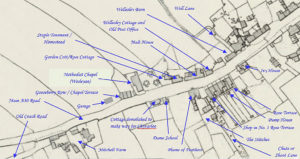
For our walk, we’ll start at the foot of Carland Hill, at the old Newlyn turn as you enter the village from the west. On the right was the mowhay gate to Mitchell Farm, which we called Higher Yard Farm, and the start of the old sunken coach road. It ran parallel to the main A30 road up to the higher ground and was nearly all overgrown, a home for badgers and a place for tipping almost anything. It has been filled in since the Second World War. On the left was a stone depot and the milestone (the milestone disappeared in the 1990s with the construction of the new bypass). Next, on the right, was Higher Yard itself and just behind that was a spring and, at one time, a mill pool and a waterwheel. The wheelhouse still remains in what was the barn. Claude and Percy Martin ran the farm in the mid-1930s and Mrs Warlick, who had a daughter called Gwenny, was their housekeeper. Claude was a member of Bellamy and Partners and was the estate agent for Trewithan: after he married he moved to Shepherd’s House at Shepherds). Claude was a good friend of my father’s and was a frequent visitor to our farm. During the Second World War he was a captain in the local Home Guard. Percy Martin continued to run the farm until he married and moved to Treworlas Farm and John Vian moved there in the late 1930s. There were a lot more trees in this area back then and the fields were much smaller than they are now.
Almost opposite Mitchell Farm was Mitchell Garage. Tom Hambly had moved his business to there from the centre of the village by the beginning of the Second World War. The garage had a petrol forecourt and with the ever-increasing traffic through the village it must have been a good business. Those who could afford a car were able to have their repairs and tyre changes there; this was some time before vehicles had to have an MOT (Ministry of Transport) test. Behind the garage was a large yard which Tom used as his lorry and hauliers park. Later, in the mid-1960s, it was owned or run by George Spink, a cockney. George delighted everyone with his stories of serving in the army in Arabia and meeting the famous Lawrence of Arabia in the First World War. Being on the main A30 road, the petrol forecourt continued to do a roaring trade from passing motorists as did Harold Roberts in his garage at the top of Carland Hill. By then, the yard area behind Mitchell Garage, which I think was still owned by Tom Hambly, had started to look like a scrap yard. I am not sure when George left the garage but by the early 1970s a Mr Lane had bought it. This was Pop Lane as we called him and then Mike, his son, took it over in about 1976 and started his removal business called Lanes of Cornwall. The scrap yard was cleared and replaced by portable offices for his removal business. A part of the garage had been converted into a café sometime around 1972. Gladys and Ted Byrnes ran it and their son, my son-in-law, Jim, also ran the shop. It was sold in the late 1970s when Alan Lobb, a Summercourt boy, acquired the garage. The café had shut by then.
Just before the chapel, were three, small, terraced properties which the old timers called Gooseberry Row but was later renamed Chapel Terrace. Claude and Dora Hoare and their daughter Mennal lived in number one. Claude worked on the roads spraying the tar from the tanker. Nick Hosken and his wife lived in number two. He was an older man who helped out on the farms at harvest time. Mrs James, who farmed Polly Mounter, later moved to there. Wilfred Morcomb, a trapper, and his wife lived in number three, the one nearest the chapel. Wilf was the first man to let me fire a shot gun and I helped him and my father move rabbit gins many times. Mr and Mrs Rogers later lived there and for some time my daughter, Shirley, and my son-in-law, Jim, lived in one of them before they moved out to Fiddlers.
 Mitchell Chapel late 1800s/early 1900s with a cottage opposite which was eventually demolished to make way for Chyvalroe which was set further back and at a higher level.
Mitchell Chapel late 1800s/early 1900s with a cottage opposite which was eventually demolished to make way for Chyvalroe which was set further back and at a higher level.
Mitchell Methodist Chapel was a beautiful building with a large meeting hall. It was originally called the Wesleyan Methodist Chapel and opened in 1845.
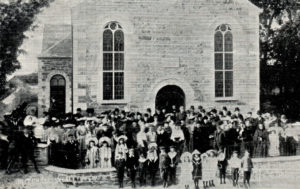 1905 Chapel re-opening
1905 Chapel re-opening
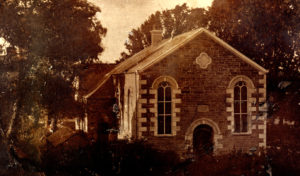 Mitchell Chapel after the 1905 alterations
Mitchell Chapel after the 1905 alterations
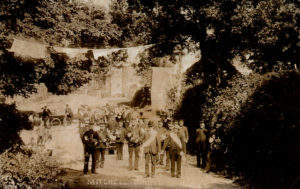 This lovely old photograph of an early event was taken from near the chapel with the end of Rose Terrace far right and the Malt House on the left. The banners are across the road and, to the left of the band, two chaps are leaning on their bicycles.
This lovely old photograph of an early event was taken from near the chapel with the end of Rose Terrace far right and the Malt House on the left. The banners are across the road and, to the left of the band, two chaps are leaning on their bicycles.
In 1905 the chapel was enlarged and a schoolroom added at a cost of £800. The chapel was the centre of so many of the village activities with the large meeting room being used for tea treats and concerts. Our chapel and Sunday school was a very busy place with the Rechabites and the Mitchell Band of Hope also meeting there.
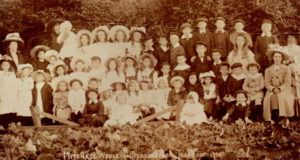 Mitchell Wesleyan Sunday School tea treat 1910
Mitchell Wesleyan Sunday School tea treat 1910
 Mitchell Band of Hope tea 1914
Mitchell Band of Hope tea 1914
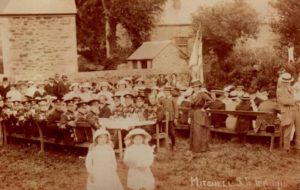 Mitchell Sunday School tea treat 1915
Mitchell Sunday School tea treat 1915
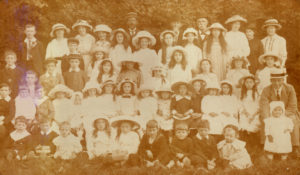 Mitchell Wesleyan Sunday School tea treat 1915
Mitchell Wesleyan Sunday School tea treat 1915
Ashley House, a residential property, was built in Plantation Field, next to the chapel, where I had once had fun playing with the other village children. Many years ago, there was a rookery in the tall trees but a local resident was not happy with the noise they made and kept shooting at them in their nests. The rooks left and never returned.
Opposite, on a bank, was a garden that belonged to Claude Hoare and next to that was a bungalow called Chyvalroe. Mr and Mrs Gordon Ferris and Bruce, their son, lived there. On some of the old photographs there is a house on the edge of the road and I can only think that it was knocked down well before I was born to make way for Chyvalroe to be built higher up the bank.
Gordon Ferris was the village carpenter and no matter what was wanted, a gate, a cart, a wheelbarrow, or a coffin, I never saw him with a plan or a drawing in his hand. There were no electric tools in those days, it was all done by hand. Just below his bungalow was his carpenter’s shop, a very old cob building which at one time was a dame school, referred to by some as a penny day school. I cannot remember anything other than Gordon’s carpenter’s shop there.
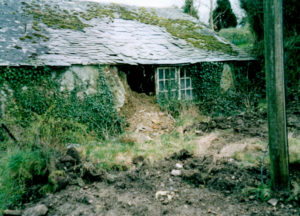 Gordon Ferris’ carpenter’s shop – previously a dame school (Photo 2003)
Gordon Ferris’ carpenter’s shop – previously a dame school (Photo 2003)
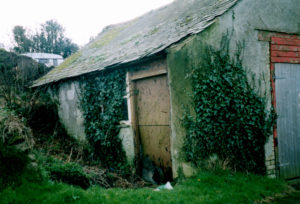 Gordon Ferris’ carpenter’s shop – previously a dame school (Photo 2003)
Gordon Ferris’ carpenter’s shop – previously a dame school (Photo 2003)
The telephone kiosk was placed next to the carpenter’s shop when it arrived in the village several years later.
Opposite was Garden Cott, a tied cottage to Mitchell Farm. I think Mr and Mrs Doney lived there. Much later it was re-named Rose Cottage. A pool beside the wall of this property was once used for washing clothes, the water coming from the overflow of the mill pool at Mitchell Farm. There was a grass verge from the gateway of Garden Cott down to Staple Tenement (now called Homestead) which was a small holding farmed by Mr and Mrs Guest. Brian Trevail moved into Homestead and by the end of 1978 he had a small business, selling second-hand furniture, from the ground floor of the Malt House.
Opposite Staple Tenement was a small meadow and then the Plume of Feathers pub: an old coaching inn which can trace its history back to the 16th Century. It was a stopping place for Charles Wesley and there is a story that the landlady chased him out of the village on one occasion.
When I was a young lad, the pub well was some 12 to 15 feet from the back door and was fitted with a rotary pump; my job was to pump the water up to the storage tank in the roof.
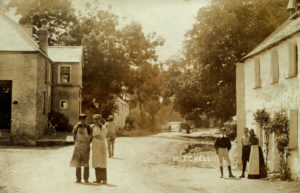 A 1905 photograph looking westwards up the main road. At this time the cottage opposite the chapel still existed, the Plume of Feathers public house is on the left and on the right are three people standing by the entrance of Wellesley Cottage.
A 1905 photograph looking westwards up the main road. At this time the cottage opposite the chapel still existed, the Plume of Feathers public house is on the left and on the right are three people standing by the entrance of Wellesley Cottage.
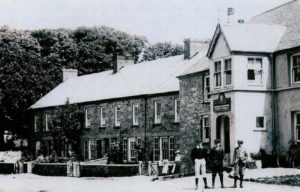 The Plume of Feathers and Rose Terrace beyond
The Plume of Feathers and Rose Terrace beyond
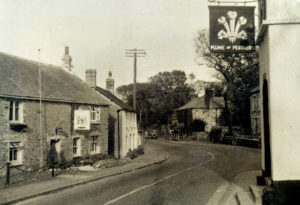 The Plume of Feathers on the right, opposite the Malt House with its St Michael’s Weavers signage
The Plume of Feathers on the right, opposite the Malt House with its St Michael’s Weavers signage
Behind the pub were a number of farm buildings and on the floor of the barn there were brass studs for the pins of an indoor bowling alley. Some years ago, in a narrow meadow at the back, there was evidence which suggested there was an outdoor bowling alley.
I am sure that Mr Bray, who was also a butcher, and a Mrs Walker were the pub landlord and landlady, and they were followed by Fred Brenton but my memory may have failed me here. In times past, the old men of the village would often sit around the large open fire and stick red hot pokers in their pints of beer.
 Looking westwards – The Plume of Feathers on the left and the Malt House opposite with Homestead, Mitchell Chapel and Gooseberry Row beyond. Gordon Ferris is standing in front of the car.
Looking westwards – The Plume of Feathers on the left and the Malt House opposite with Homestead, Mitchell Chapel and Gooseberry Row beyond. Gordon Ferris is standing in front of the car.
Claude and Dora Hoare ran the Plume of Feathers and in the late 1950s or early 1960s it passed to their son-in-law and daughter, Frank and Mennal Smith. Frank was from London and met Mennal when serving at RAF St Mawgan during the Second World War. They moved to Homestead smallholding (previously Staple Tenement) shortly after the war before moving across the road to live in the public house. Later, when they retired, they had a bungalow built in what was Claude’s garden, opposite the chapel, and called it Amanah. John Dart with his wife Pauline took over the Plume of Feathers in about 1976: he had grown up in Quintrell Downs. The two pillars at the front are replacements, the originals were damaged after a lorry drove into them several years ago. The two walls leading into the entrance were also demolished and never rebuilt. Following the accident, the lime and whitewash was removed revealing the stonework. The original stone pillars were said to have come from the Coinage Hall in Truro when it was demolished. Several internal changes were made and much of the ground floor was converted into a restaurant. John and Pauline left there in about 1984 and moved to the Isles of Scilly to take over the Mermaid Inn. I think it was shortly after that Devenish Breweries were taken over and several people managed the pub until it was sold sometime in the late 1990s and moved into private hands. Many of the old buildings connected with the pub: the barn, cowsheds and pigsties were knocked down about 10 years ago (2001) when holiday accommodation was added and the restaurant enlarged even further. It became very popular. Later, the internal bar area was altered again and an even larger restaurant formed. I think the only original interior part, which is a bit of a feature, is the old well.
Plume of Feathers 2001 Alterations
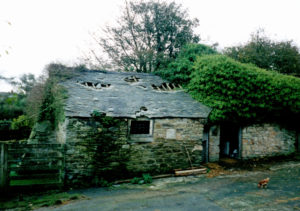
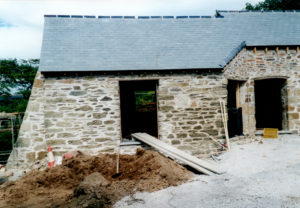

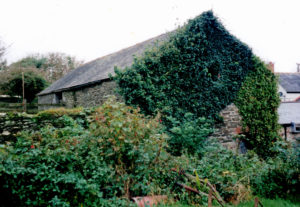
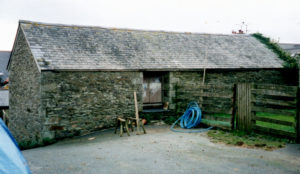
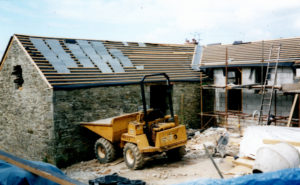
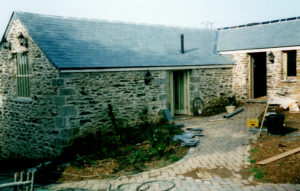
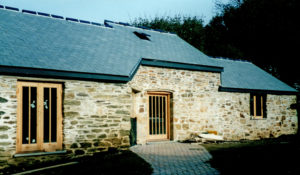
Behind the pub were some narrow meadows called the The Stitches (Stitch referred to the space between two double ploughed furrows in early open field strip farming).
Between the Plume of Feathers and Rose Terrace was a sunken lane leading up to Hendra Gate on the Carland to Ladock road called either Chute Lane or Shoot Lane but I have never seen the name written so I can’t be sure. A little way up the lane, a long time ago, someone dug into the side of the lane and spring water sometimes ran from it. It could be that this water chute gave it its name but the older people told a different story. It seems that a small unit of soldiers was stationed in Mitchell to protect the coach route or to protect the excise officer (in St Newlyn East Churchyard there is a headstone to the wife of the Mitchell excise officer). It was said that the soldiers went to Hendra for training (over towards Carland from Hendra Gate is a field called Artillery Downs) so was it shoot lane?
 Chute or Shoot Lane to Mitchell Downs taken in 1982. The Plume of Feathers public house is on the right and number one Rose Terrace on the left. Note the shape of the removed roof on the side of the building on the right, and the later block wall.
Chute or Shoot Lane to Mitchell Downs taken in 1982. The Plume of Feathers public house is on the right and number one Rose Terrace on the left. Note the shape of the removed roof on the side of the building on the right, and the later block wall.
Back across the road, and next to Staple Tenement, was the impressive building called the Malt House with its pair of double doors facing the road. The first led into a small room and the stairs. On the right at the top of the stairs was a small room and on the left a long room with double doors at the end facing Staple Tenement. I think that at some time in the past these doors would have been used to access the Malt House grain floor. The small room was converted into a church complete with a small organ and a single bell hung out of the window. Charles Hawke, who lived at Wellesley Cottage, summoned people to the service by ringing the bell on Sundays. It was said he had a difference of opinion with the vicar of St Enoder Church and started a church congregation here. The old church room ceased its original use during the war years [Second World War] and dear old Charley Hawke had passed away by the middle 1960s. The large south end of the first floor was used for dances, concerts, garden events and magic lantern shows – there was also a small room with a hatch to serve tea and food. It had exposed roof joists, usually full of cobwebs, and using oil lamps did not improve things. In the early 1940s we young lads had a go at cleaning the room. Climbing about on the roof joists I dislodged a small green cloth bag and inside were a number of tickets dated 4th May 1857 for Mitchell Wesleyan Chapel tea.
 The 1857 tea treat ticket
The 1857 tea treat ticket
Beneath the first floor was a storage area full of planks of wood, carpenters trestles, wood formers for making flues in cob walls and all sorts of other things. The rest of the ground floor under the main hall was a cow’s house for Staple Tenement.
This building also provided accommodation for St Michael’s Weavers but more about that later.
Next to the Malt House, was a stone and cob cottage, Wellesley Cottage, where the Hawke family lived. Attached was a small galvanised roofed post office. Charles Hawke, Justice of the Peace, parish councillor and self-appointed mayor of Mitchell ran the post office which was internally accessed by a door from the cottage.
Charles Hawke and his brother, Stan, ran a corn and seed business and sold artificial fertiliser. They had a stall at St Columb on market day.
 Looking eastwards with Wellesley Cottage and the old post office on the left
Looking eastwards with Wellesley Cottage and the old post office on the left
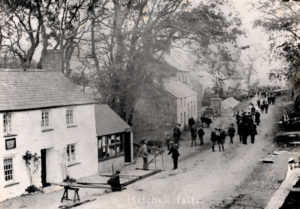 Wellesley Cottage with the attached single-storey post office. The sign on the cottage wall was probably advertising the Hawke’s corn and seed business.
Wellesley Cottage with the attached single-storey post office. The sign on the cottage wall was probably advertising the Hawke’s corn and seed business.
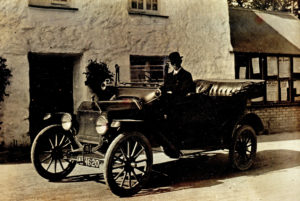 Charles Hawke in his car outside Wellesley Cottage and the galvanised roofed post office. He was one of the first persons in Mitchell to have a car.
Charles Hawke in his car outside Wellesley Cottage and the galvanised roofed post office. He was one of the first persons in Mitchell to have a car.
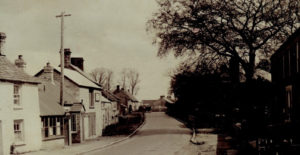 By the time that this photograph was taken, two buildings have been erected between the old post office and Wellesley Barn. Fred Hambly has built a bungalow with a porch and the large building next to it is a store for the Hawke’s corn and seed business. Note the sign on the front. In the distance is a signpost for the new Newquay road built circa 1930.
By the time that this photograph was taken, two buildings have been erected between the old post office and Wellesley Barn. Fred Hambly has built a bungalow with a porch and the large building next to it is a store for the Hawke’s corn and seed business. Note the sign on the front. In the distance is a signpost for the new Newquay road built circa 1930.
When the Hawkes moved out, Archie Hoskin and his wife moved to here. Archie had a lorry and coal round, sold cement, bricks and blocks and also did haulage work.
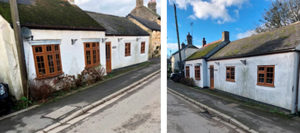 During the 1970s it was all change again. The post office closed circa 1972 and was demolished to become a vacant plot (note the car on the left, by the pole). The corn and seed store was removed and its area used as a lane to access the water works. Subsequently, the little bungalow was altered and extended and is now called Glenholme.
During the 1970s it was all change again. The post office closed circa 1972 and was demolished to become a vacant plot (note the car on the left, by the pole). The corn and seed store was removed and its area used as a lane to access the water works. Subsequently, the little bungalow was altered and extended and is now called Glenholme.
Across the road was Rose Terrace which I was told had been built for overseers at East Wheal Rose Mine. Frank Dungey, his wife, and Mrs Dungey’s father and children lived in number one. Her father, Jan Trethewey, often related tales of sailing around Cape Horn and being in the Roaring Forties in three-masted sailing ships. He rode a tricycle and the boys in the village would have fun trying to ride it. There were two doors at the front of number one, one led to a passageway into the house and the other opened into the shop. This was run by the Nancarrows who also had a shop in Albert Square, Summercourt.
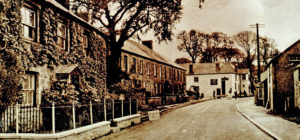 Ivy House nearest camera and Rose Terrace beyond – I live in number two, next to the shop at the far end. No doubt the warning sign by the large tree is due to the road-line work in progress.
Ivy House nearest camera and Rose Terrace beyond – I live in number two, next to the shop at the far end. No doubt the warning sign by the large tree is due to the road-line work in progress.
My grandfather moved to number two when he retired from Trevilson Farm in 1939. Previously, Mrs Menhire and her son had lived there before moving to Plymouth. When my parents retired from farming at South Nancemeer in 1943, they and my brother Bill (William) lived there. Bill had worked for Frank Davey as an agricultural engineer since leaving school. Following my father’s death in 1961, my mother and brother remained there until her death in 1977 when Doreen and I moved to there.
Granny Glouis and Mrs Ely, old ladies who always dressed in black, lived at numbers three and four and at number five was Mrs Roberts, a widow, and her daughter, Kathleen. They had two lodgers: Tommy Lock who was a partner with Ernie Roberts at Carland Garage and Ed Tregunna who was always referred to as Uncle Ed. He used Mr Menhire’s shed for repairing boots and shoes. Mrs Roberts’ husband had been killed in the 1914-18 war. She ran a small business selling cigarettes and tobacco.
John James (JJ) Morcomb lived at number six with his wife and family. He had a couple of Meadows at Carland and was involved in trapping rabbits with his sons, Wilf and Harry. He also had a pony and trap with stables in a couple of sheds in Green Lane. When the pavements were first laid he had a ring fixed in the curb stone outside where he tethered his horse.
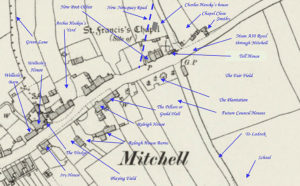
Ivy House is just beyond Rose Terrace and the old folk said it was built from the stones of the cottages that were destroyed by Sir Christopher Hawkin during the Rotten Borough period. The Luscombe family lived here together with Mrs House, a widow, with her son and daughter. Digby Hawke, who I think was the owner, lived here until he went to St Columb Minor. Later, William John (W J) Trebilcock and family moved in after he retired from farming at Trelassick.
Opposite was a building which was always referred to by the older folks as the Town Hall (much later it was called Wellesley Barn) which Mr W Menhire used as a cow shed. There was a bit of a mowhay (a farmyard) behind and then a square level of ground. We were always told it had once been a bowling green. This was linked by an archway, to Wellesley House, and was used as the pathway to a public well.
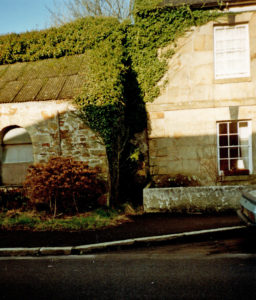 Wellesley Barn on the left and Wellesley House on the right with the archway between, leading to Well or Pump Lane
Wellesley Barn on the left and Wellesley House on the right with the archway between, leading to Well or Pump Lane
Before a mains supply was installed, the people from Chapel Terrace, Chyvarloe, Wellesley Cottage, Ivy House, the Wedge and other houses fetched their water from Well Lane. The well was on the side of what was referred to as the Bowling Green and folk had to dip their bucket or pitcher to get the water.
The Menhire family lived in Wellesley House which had been built by the Bassett family of Tehidy: it had beautiful relief ceilings in the bedrooms. Billy Menhire had a small farm and was the chapel secretary.
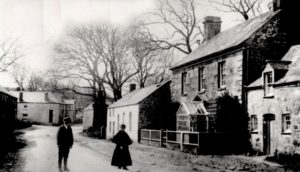 The Plume of Feathers is in the distance on the left and on the right and behind the lady is Wellesley Barn. Next to that is Wellesley House and on the extreme right is The Wedge.
The Plume of Feathers is in the distance on the left and on the right and behind the lady is Wellesley Barn. Next to that is Wellesley House and on the extreme right is The Wedge.
The Wedge was next to Wellesley House and was the home of Will Roberts and family. Will worked on different farms and later moved to somewhere in North Cornwall. He was a brother to Gentleman Jim Roberts who had a bungalow out near our farm (South Nancemeer) but on the Degembris road.
Behind The Wedge was another old Cottage, Staple. I cannot remember anyone ever living there but can recall going in there once when I was a boy. It had an old open fireplace and still in place was an adjustable iron arm with hooks for cooking pots which could be swung over the fire.
Next were the remains of another derelict cottage and there were more cottages on the left of Green Lane which the old folk said had been knocked down years ago. Some of the derelict cottages were rebuilt and two council houses were built in the mid-1960s, just past Green Lane where cottages had once stood. At one time Green Lane joined the road to Newquay.
Beyond Green Lane, on the left and fronting the road, were the remains of another ruined building. I can mind Claude Hoare saying that he knew this dwelling when he was a young boy. It had plastered relief ceilings and older folk said this was where soldiers were billeted.
Behind these ruins was a courtyard with a well and an entrance into Green Lane where there were three more ruined buildings, one with a bit of a barn which was once used as a small blacksmiths shop. It was at the start of what was Archie Hoskins’ yard.
By the side of this building was another old building and a barn. I don’t recall the barn being used for anything but you could always find barn owls there.
 A parade with Newlyn East Band which was formed in 1911 so it is later than that. The wooden building was Gordon Ferris’s first carpenter’s shop and beyond that is the row of thatched cottages.
A parade with Newlyn East Band which was formed in 1911 so it is later than that. The wooden building was Gordon Ferris’s first carpenter’s shop and beyond that is the row of thatched cottages.
To the right of the entrance to Archie’s yard was Gordon Ferris’s first carpenter’s shop, before he moved to the old dame school. Later, Tom Hambley used it as a garage before it became a Home Guard base during the Second World War. By then, Tom had built a new garage near the Methodist Chapel.
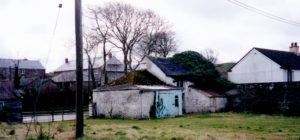 Archie’s Yard where Gordon Ferris kept a couple of cows.
Archie’s Yard where Gordon Ferris kept a couple of cows.
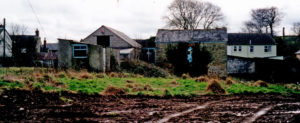 Barns at the back of Archie’s Yard
Barns at the back of Archie’s Yard
The Ivy covered semi-derelict house was converted and used by John Parkin as an office for his horticultural and garden retail machine business. Shortly after, Archie Hoskins’ former coal yard, which had been in disuse for several years, was redeveloped by Mr Parkin and a large garden machinery showroom built there. The old, wooden building where the Home Guard trained and which my brother, Bill, had used after the war as a garage for his car, was also taken over by Mr Parkin for garden machinery repairs.
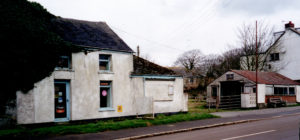 Parkin’s frontage late 1970s: the dwellings on the right, beyond the old carpenter’s shop/garage have been refurbished with slate replacing the thatch
Parkin’s frontage late 1970s: the dwellings on the right, beyond the old carpenter’s shop/garage have been refurbished with slate replacing the thatch
Mr Parkin’s garden machinery repair business closed in the early 1990s and the area was then redeveloped as residential use. The original office building was mostly demolished and a new house built which now stands next to the two council houses by the sign which says Hawkins Place.
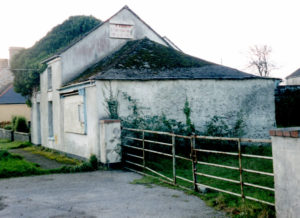 2001 – John Parkin’s old office before its conversion to a dwelling
2001 – John Parkin’s old office before its conversion to a dwelling
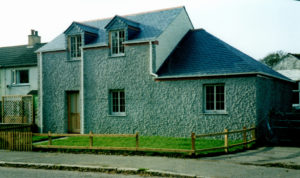 The dwelling which replaced John Parkin’s office
The dwelling which replaced John Parkin’s office
Beyond Archie’s Yard was a row of thatched cottages. Percy Morcomb lived in the first one and then there was Mrs Pinch and her family: Mr Pinch had worked on the roads and lost his life falling from a tree whilst lopping branches in Butts Hill, Newlyn East. Ambrose Matthews and his son, Sid, also lived in the row. Sid used to say he was going to build an aeroplane but I never did see it. (This reminds me that about this period we would sometimes see Ron Bullocks’ homemade aeroplane chugging along – it looked like a collection of orange boxes. It was said to have been driven by a Douglas motor bike engine). Also in the row of thatched cottages was a family called Trebilcock, Dick Morcomb and his family, the Cook family who moved from there to Newlyn East, Harry Morcomb who moved to Wellesley House and Simon Trevethan and his wife. Simon worked on my grandfather’s farm at Trevilson but the poor chap was killed in the Second World War. His wife and son, Garfield, then moved up to the council houses when they were built in 1955. There was also a Mr and Mrs Wild. The older folk said that he was a lion tamer and that she was a trapeze artist: she would always be singing when out walking. In the last house was Simon Rose who had a small blacksmith shop for a while.
 Looking westwards towards the thatched cottages with an early Mitchell fair in progress. The area behind the group of four men is where the new Newquay road was formed.
Looking westwards towards the thatched cottages with an early Mitchell fair in progress. The area behind the group of four men is where the new Newquay road was formed.
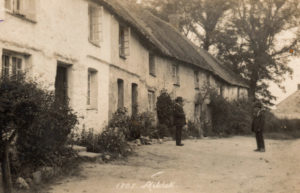 The thatched cottages
The thatched cottages
The row of cob and thatched cottages fell into disrepair but by 1960, refurbishment was underway. Stan Davis, a carpenter builder, rebuilt the first one. He and his wife, Sheila, called it Sheridan House and lived there with their daughter, Shirley, and son, Christopher. They were caretakers at the Pillars Hotel between owners before moving to Australia shortly after the house was completed. They returned to Cornwall several years later. The remaining cottages were rebuilt and more families moved in.
Opposite these houses, and next to The Pillars, was Raleigh House where Mrs Avril Dungey and her two daughters lived with Preston Ball who ran the farm. Later, a Mr Dunstan farmed there. The house and farm was then occupied by Jack Waters and family and when he retired, his sons Paul and Roger took it on and ran it for several years – well into the early 1990s.
The Barns at Raleigh Farm
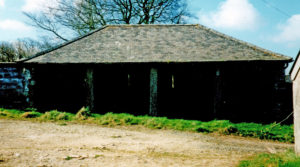 This building was at the top of the lane beside Raleigh House, on the right. It is now a house and the playing fields are directly behind it.
This building was at the top of the lane beside Raleigh House, on the right. It is now a house and the playing fields are directly behind it.
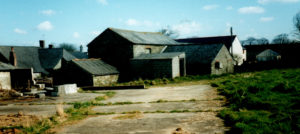
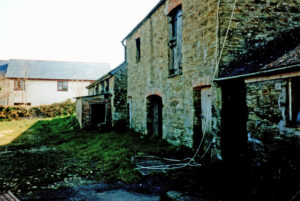 These barns were behind and parallel to Raleigh House. The new houses in the background were built to the rear of the Pillars Hotel.
These barns were behind and parallel to Raleigh House. The new houses in the background were built to the rear of the Pillars Hotel.
 Another view of the above barn
Another view of the above barn
At some stage, the owners, either Trewithan Estate or Cornwall Council, decided to sell the farm and the barns along the rear of the yard were eventually turned into houses. The farm had a beautiful orchard, just above where the playing field is now: there were some lovely apples to be found there, cookers and eaters, but now it is all gone, replaced by yet more houses. It seemed that any area suitable for a house was being built on.
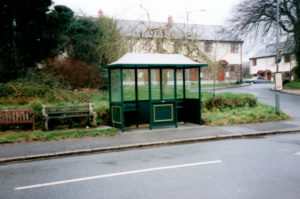 Circa 2001: the bus shelter opposite the new Newquay road with new houses in the background.
Circa 2001: the bus shelter opposite the new Newquay road with new houses in the background.
Next to Raleigh House was The Pillars, the former Guild Hall, which was a small farm and the home of Digby Hawke. No one remembers the building as a guild hall. There were double doors leading to the farmyard. I remember that Digby would save up his cigarette cards and when we were walking home from school he would throw them in the air and we would scram for them.
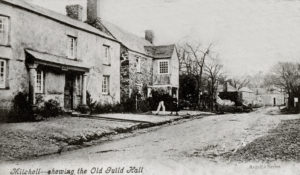 Looking westwards: the Guild Hall (Photo: Argall Series)
Looking westwards: the Guild Hall (Photo: Argall Series)
To the left of the The Pillars was a track or lane which led to the fields and beyond that was a small plantation of trees, next to the road to Ladock.
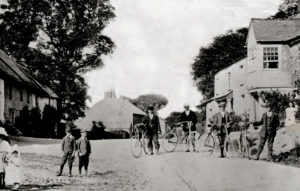 Looking eastwards, Raleigh house and the Guild Hall is on the right and on the left are the thatched cottages. Beyond them was where the new Newquay road was formed. (Photo: Argall Series)
Looking eastwards, Raleigh house and the Guild Hall is on the right and on the left are the thatched cottages. Beyond them was where the new Newquay road was formed. (Photo: Argall Series)
The new Newquay road was formed in the late 1920s or early 1930s and beyond this was the last row of houses before the crossroads. The first was single fronted, the next double fronted and the last two single fronted again. At some time, and I cannot remember when, the last two houses were altered to form a double fronted house. The first one was originally called Woodbine Cottage (later Laddel) and Mrs Sparkes lived there with Miss Turner, the schoolteacher, as her lodger. The schoolteacher after Miss Turner was Miss Francis Hawke who either lived or lodged in this same row. Others who lived in this row were Richard (Dick) Trevail when he left Mitchell Farm, George Heather and his wife with their lodger, Simon Trevena, Fred May and his family and Mr Chalk and his housekeeper, Mrs Tregido. Laddel is where Joyce and Clarence Morcomb lived and ran Mitchell’s second post office which transferred to there in the 1970s. It has now closed but the post box is still located there and their son Terry and his family still live in the same terrace. Fred May was the village blacksmith and when he retired he lived in the double fronted house. Mitchell, in the early 1960s, had a Father Fred May because his son was called Fred and a Father Les Donnithorne and Boy Les, my son! There well may have been others who had moved in or out over the years but I cannot recall their names.
Charles Hawke and his brother built a big, semi-detached, house on the new Newquay road, on or near the site of the ancient chapel. It was built using East Wheal Rose blocks and this caused a lot of problems because of the mundic and arsenic present in the sand. There were two bungalows opposite St Francis, these were By-the Way and Kelowna, the latter being where Mr Parkin lived, I believe.
Just past the terrace was the last house before the crossroads – The Toll House. It was a very small, two up and two down house. A chap called Morcomb lived there, I think, before it became the home of Gordon and Amy Letcher. They moved to Fraddon in the early 1970s and a new dwelling was erected. One little bit of information concerning the demolition of the Old Toll House was that my wife found a four pence groat on the side of the road when the rubble was being removed.
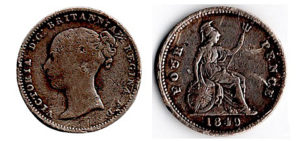 The Groat
The Groat
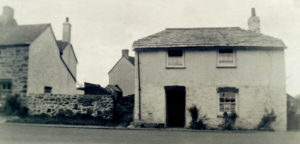 The Toll House with the gable end of Charles Hawke’s house, St Francis, immediately behind it. The crossroads and the old road to Newquay is just out of shot, on the right.
The Toll House with the gable end of Charles Hawke’s house, St Francis, immediately behind it. The crossroads and the old road to Newquay is just out of shot, on the right.
Beyond the crossroads was the blacksmith’s shop of Harold Ferris and Fred May. They had two forges in the shop and a wooden shoeing shed and when I was a bit older I worked the bellows. Another of my jobs was to stand by with a pail of water when they were fitting the steel rims onto the wooden wheels. Gordon Ferris, Harold’s brother, made the wooden wheels and the steel rim would be put on while it was still red hot and the water poured on to douse the rim and shrink it tight to the wheel fellies. Gordon would tell us boys that it took three types of wood to make a wheel. I remember that above the main forge was chalked all the names of the previous blacksmiths. It is a great pity I never realised what value that information would be in years to come.
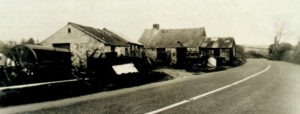 The Blacksmith’s Shop
The Blacksmith’s Shop
The blacksmith’s shop became Royston Bullen’s Agricultural Engineers sometime in the late 1950s, I think, and when he retired it was run by his son, Eric.
A short distance up the hill on the Ladock road, and on the left, was Mitchell School. It was actually in St Enoder Parish. It opened in 1909 in what some called Ladock Road and others referred to as School Lane. To the older folk it was Pound Lane, perhaps because of the small enclosure at the top of the hill which may have been a pound for stray cattle or maybe because it led to the village of Grampound.
Memories of people and events
The early 1930s
I remember many of the families who were in Mitchell when I was a boy attending Mitchell and St Newlyn East School, when I was in my early teens and during the post-war years.
For a young boy, Mitchell was a very active place to grow up. We would go to the blacksmith’s shop to watch Harold Ferris and Fred May at work, or to Gordon Ferris in his carpenter’s shop and some Sunday mornings we would go over to Archie Hoskin’s coal and haulage yard and play Pitch and Toss. We had all sorts of things to keep us amused – either in or out of trouble as boys will be!
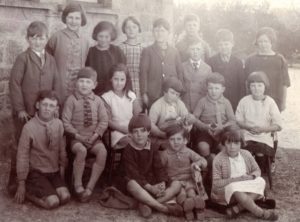 Me on the front row with my toy horse which always accompanied me to school and almost everywhere I went. My brother, Bill, is second right in the middle row.
Me on the front row with my toy horse which always accompanied me to school and almost everywhere I went. My brother, Bill, is second right in the middle row.
Billy Bennetto’s coach service to Truro was quite regular but if we wanted to go to Newquay or Perranporth, or further afield, we would have to walk down to Mitchell and Newlyn Halt, about a mile-and-a-half, and catch the train.
The village had a treat in about 1934 when Sir Alan Cobham and the St Austell Aviation Company gave a flying display up at Carland. They flew bi-planes and it was a great day out for us watching them perform all kinds of flying stunts.
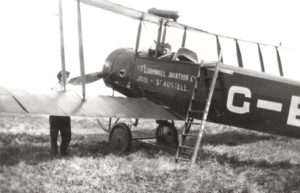 Sir Alan Cobham in Carland Field circa 1934
Sir Alan Cobham in Carland Field circa 1934
In 1934 the Mayor of Truro was making a speech during the inauguration of Truro Carnival Week. He eulogised about the fine work carried out by Mitchell on behalf of the Royal Cornwall Infirmary and urged his audience to emulate this little village. The speech was reported in the West Briton but it didn’t please everyone. Charles Hawke wrote to the newspaper on the 23rd July 1934 saying, “… the Truro Mayor, I am quite sure, quite unintentionally, used just two words which on reflection he should not have used. He referred to the poverty-stricken village of Mitchell.” Mr Hawke, a proud Mitchell gentleman, said that he had been approached by many Mitchell people asking him to put it right. He continued, “The true facts are these: only one person in the village is temporarily unemployed, one third of the residents live in their own houses, many are retired from business and living on their means, all the other residents are working and are happy. So, in comparison with some villages, and even Truro itself, Mitchell is one of the bright spots in Cornwall.”
There was a further exchange of letters on the subject, I believe, but Mr Hawke rounded it off with some suitably poetic words which were published in the papers.
1936 to 1943
When I was a boy I pumped the organ for the Sunday service which was often taken by local lay preachers. On one occasion, Mr Trembath was in the pulpit with Billy Manhire on the organ. Mr Trembath said, “We will now sing hymn number so and so …”.
Billy responded, “No, Mr Trembath it’s hymn number so and so …”.
Mr Trembath replied, “No, No, Mr Manhire it’s hymn number so and so…”.
Billy Manhire replied, “Very well, we will sing to the tune of one and the words of the other”.
On another occasion I remember that Billy Manhire had forgotten his glasses so he tried on everyone’s from the congregation until he found that Dora Hoare’s glasses were just right. Many years later George Yelland used to go to the Sunday service with his son’s comic, he would read that and then go to sleep. The tea treats were held in the meadow behind the chapel where the children would enjoy their big saffron bun and fruit juice or tea. The meadow was also used for various events including the crowning of the carnival queen. We also had Sunday school outings – usually to Perranporth – carnivals and hospital Sundays.
When we were youngsters we would gather in the plantation next to the chapel and play old games. They were mainly played in a circle of boys and girls and included Boy and Girl around the Ring, In and Out of the Window (when the song stopped you had to stand and face your lover), London Bridge is Falling Down, Ro Oh Merry Oh, Farmer in the Dell, The Farmer Takes a Wife, Oranges and Lemons and so forth. All of these games were played at various village events often with many of the older villagers joining in depending on what the occasion was. I remember one particular tea treat, in late May or early June 1943, when the young and old of the village all joined in the activities – including the games and dancing. A new family had recently moved to the village and their daughters joined in. During the following month I saw the eldest sister several times when I was in the village but not to speak to – I found out later that she was called Doreen Knowles.
At the outbreak of the Second World War, I was a founding member of Newquay Air Training Corps and was appointed to a wartime youth role as a police messenger complete with an arm band to inform everyone of my civil responsibility.
When I was fifteen I had my first bike, second hand from Langdon’s in Truro. It was a Raleigh three-speed machine that cost me thirty shillings, that’s 1.50p in today’s money. That bike made quite a difference to my life.
My Three-Speed Bike
(Les Donnithorne)
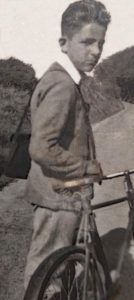 Me and my three-speed bike on the day I bought it.
Me and my three-speed bike on the day I bought it.
I rode it to work; I rode it to play in fact I rode it everyday.
Out in the sunshine, out in the rain, into Newquay and back again.
Down the hill past Ingram Cott… I used to go this way a lot.
I would ring the bell and peddle like hell on my three speed bike.
On the way to Fiddlers Green, walking on so serene,
Out in the middle of the lane was Mrs May with her walking cane.
As I went by I tipped her hat. “Hey you,” she called, “that’s enough of that”.
So I rang my bell and peddled like hell on my three speed bike.
Going down past Cargoll Pool, Fred stood on the bank, silly old fool.
“Boo Fred,” I shouted – splash – he was in the pool waving his arms about.
“There,” he cried, “see what you’ve done”. “Well Fred,” I said, “twas all in fun”.
So I rang my bell and peddled like hell on my three speed bike.
I gave Mary a ride on my cross bar, she said, “My love are we going far?”
She had one arm around my neck, “Marry me and be my pet”.
I dumped her off just past Tregear. “Marry you, no blooming fear!”
So I rang my bell and peddled like hell on my three speed bike.
Out Long Cross it was getting late, a courting couple by the gate.
He had his hand, where never you mind, “by heck,” I thought I wished twas mine.
I yelled out, “Good night Willy”and they soon parted looking silly,
so I rang my bell and peddled like hell on my three speed bike.
Alas, now I am growing old, wearing thermals to keep out the cold!
There, on top of a waste haul skip on its last journey to the rubbish tip,
my old bike, just a rusty frame, no longer can I read the maker’s name.
I tried once more to ring the bell – would it work, would it hell,
so I said, “Good bye” to my three speed bike.
At fifteen I began work with the meteorological station at Rosecliston near Trevemper Bridge: I had to cycle there every day on my new bike. I then moved to work with Costain Construction who were building the St Eval Airfield. They provided a works bus which travelled to and from Truro to the airfield site daily.
The village shop in Rose Terrace was still serving the villagers as was the post office, the blacksmith’s shop, Archie Hoskins’ coal yard and Mr Hawkes corn and seed business. Mitchell Wesleyan Methodist Chapel was still the centre of many village activities, and dances and other social events were still being held in the Malt House. It closed a little later but opened up again when the Second World War started to provide for the evacuees in the village. The Infants school had closed for a short period of time but it too, reopened to accommodate the London evacuee children who were being lodged in Mitchell.
Things were to change at the beginning of the Second World War. By then, Hambly’s first garage, at the entrance to Archie Hoskins yard, had become the base for Mitchell Home Guard unit which held their parades there. They were sometimes joined by the units from St Newlyn East and Zelah. My brother, Bill, was in the Home Guard along with Jack Waters and several other village chaps. I used to watch them doing their training which is how, when I was called up into the army, I already knew how to strip and assemble a .303 Bren gun.
 Mitchell Home Guard Platoon
Mitchell Home Guard Platoon
Back row: Percy Morcomb, Harry Morcomb, George Yelland, Albert Buscombe, Tom Gill, Clarence Morcomb
Middle row: Fred May Jnr, Jim Goyne, Joe Trebilcock, Jack Waters, Tom Hambly, Wilf Morcomb, Jack Roberts
Front row: Glen Huthnance, Billy Donnithorne, Jim Trebilcock, Claude Martin, Fred May Snr, Leonard Hopper
One night, during the war, just after midnight, we heard a strange wailing sound. It turned out to be someone playing the bagpipes on Carland Hill: perhaps some soldiers on the move. We saw many German bombers and fighter aeroplanes in the sky over Mitchell but I cannot remember any bombing taking place. When the German bombers blitzed Plymouth we could see a red glow from the fires in the sky over the horizon, beyond St Austell.
Many days are important in a person’s life but one in particular I recorded in my diary.
Diary Date 2nd August – 1943 Grandfather’s funeral on 3rd August – met “D” .
On the 2nd August 1943 I was given the task of going to Truro on the bus from Mitchell, to collect the wreaths for my grandfather’s funeral the following day. When I caught the bus home it was quite crowded and I was fortunate to have a seat – that was until I spied a young lady standing. I had been brought up with good manners and offered her my seat. When we arrived at Mitchell we both got off and began a conversation. The rest is history, as they say, and from then on Doreen Knowles was affectionately known to me as “D”. We later married and celebrated our 66th wedding anniversary in May 2011.
In 1943 I was called up and lost touch with what was going on in Mitchell. I was initially in the Oxford and Buckinghamshire Light Infantry, and then transferred to the Royal Army Ordnance Corps finally ending up in the Royal Army Pay Corps. When I had joined up, many of the village tradesmen were still working at their professions and some families were moving out of the village and others moving in. By the end of the war, several of the older people had passed away or had moved from the village. There were also some new faces of the families who had moved in. Mitchell was beginning to change.
It was when I was enlisting that my nationality was called into question. The reporting officer asked for my father’s place of birth and I replied, “Nagaunee, Michigan, USA”. After a brief discussion they decided that I was sufficiently British to fight for my country and I was signed up. Many years later I decided to apply for an American passport and as well as being a proud Cornishman, I was an American Citizen.
 Me in army uniform circa 1944
Me in army uniform circa 1944
On one occasion, when the US army troops were moving their equipment they found that Carland Hill was too narrow so, overnight, they bulldozed down all the hedges on the north side from Stop Gate Meadow to Carland Cross. My Father farmed those fields and I missed it being done because by that time I was in the army.
1946 and through the 1950s
There is an amusing incident from the late 1940s relating to the Mitchell Drought. It was caused by a live frog becoming stuck in the supply pipe and, once again, Charles Hawke took to the newspapers with a witty poem to explain the problem.
By now, there was an electricity supply throughout the village and everyone had electric lighting. A main water supply had also been installed with water at the end of a tap. Best of all there was hot water for baths and no more outside toilets – the village pump was needed no more.
It was during this period that we had some extra mouths to feed. Firstly, a son came into our lives, Boy Les, and then in 1948 a daughter, Shirley, to be followed two years later by Sandra. Our family was now complete.
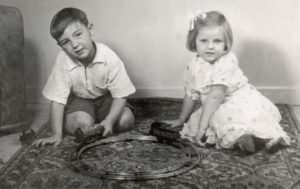 Les and Shirley
Les and Shirley
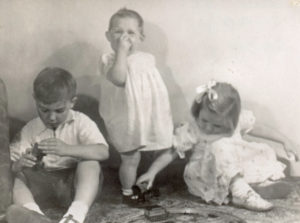 Les, Shirley and Sandra (standing)
Les, Shirley and Sandra (standing)
By this time, most of the old ways were gone and Mitchell had begun a gradual change from what it was like pre-war. We had a regular bus service to Truro and Newquay provided by the Western National but Billy Benneto still ran his coach service to Truro on Wednesdays and Saturdays. Mitchell still had a thriving garage with petrol pumps on the main A30 road. Almost opposite the chapel was the new telephone kiosk which had been placed there by the GPO (General Post Office), sometime during the war. It was to become a lifeline for the villagers because very few people had their own telephone. Many decades later this telephone kiosk was moved to a new location next to the entrance to the playing field.
The next big thing to arrive, in the early 1950s, was the television. Only a few people could afford one so most of the children visited their homes to watch Children’s Hour.
It was not easy in the immediate post war years for demobbed service personnel to find employment. Initially, I was offered a job as a weaver with Mrs Dobell’s weaving business in St Just-in-Roseland but first I had to learn the skills required – on the job without pay. Then, in 1952, I was approached by a former Indian army colonel and we decided to set up a business in Mitchell if a suitable premises could be found. As it was on the main A30 road it provided daily passing business and trade opportunities. My family’s association with the Estate Manager of Trewithan, still Claude Martin, helped in acquiring the top floor of the Malt House, opposite the Plume of Feathers. It was there that we established St Michael’s Weavers. I designed and built the looms which I operated to weave beautiful cloth patterns for clothes. A lengthy report of this venture was included in The Western Morning News of the 7th July 1953.
 St Michael’s Weavers on the left, opposite the Plume of Feathers
St Michael’s Weavers on the left, opposite the Plume of Feathers
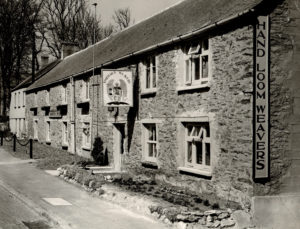 St Michael’s Weavers in the top floor of the Malt House
St Michael’s Weavers in the top floor of the Malt House
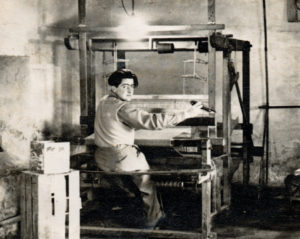 Me at the loom I designed and built for St Michael’s Weavers in 1953
Me at the loom I designed and built for St Michael’s Weavers in 1953
In about 1958, the economics were such that St Michael’s Weavers was forced to close. I was fortunate to find employment with English China Clays and stayed with them until I retired.
It was several years after the Second World War that my family returned to live in Mitchell, moving there from St Newlyn East. We were fortunate to be allocated one of the new council houses built on the Ladock Road, next to the Plantation, and looking over to the old Fair Field. The row of ten council houses built in 1954 was appropriately called Fair Park View. When these were completed, several other Mitchell families moved into them; Archie Hoskins and his wife moved from Wellesley Cottage, Percy Morcomb and his family from Ivy House, Fred May, his wife Greta and son Tony (Father Fred’s son) and Mrs Trevethan and her son, Garfield. Others who lived there then were the Sampsons, Royce Bullen and his family, Mr and Mrs Smith and Jim and Eileen Coles with their family.
The chapel had been well supported up until the war years but the congregation had fallen away and it was felt necessary to temporarily close the building for redecoration, renovation and the installation of a new organ. It was hoped that this would bring back the congregation. The Methodist Society promised £275 towards the cost. It re-opened on the 23rd November 1956 with Newquay Wesley Choir led by choirmaster Mr W H Julian and with William Hosking as the soloist. The builders, H May and Son, presented Sydney Harding with a key with which to unlock the door for the re-opening service.
Mitchell School finally closed and all the village children had to go to Summercourt Church of England School. Billy Benneto’s coach picked them up in the morning and dropped them back after school. In 1956, Tretherras Secondary Modern School was built in Newquay for children aged between 11 and 15 from the villages surrounding Newquay, including Summercourt. Mitchell children travelled to Newquay using the Western National bus service which picked them up at around eight o’clock in the morning and returned them about half past four.
Following the closure of Mitchell School it was decided that the building would be used as a meeting place and it became the men’s institute. A snooker table was placed in the large, one-room classroom and a small iron stove installed. The men, young and old, would meet to play snooker or sit around the coal-burning stove to swap yarns but as the old timers passed away the younger ones found other entertainment and by the 1980s the old school became redundant again.
Carnivals were held in the summer every year. These were well supported by all of the village folk who entered in their various costumes: they were great events and brought people together.
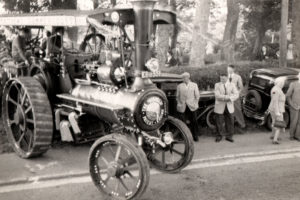
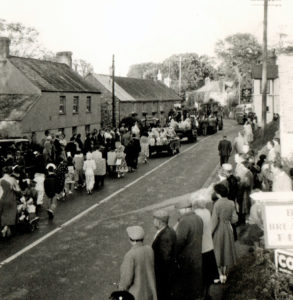 The annual carnival – circa 1958
The annual carnival – circa 1958
The 1960s to 1990
I mentioned that most of the old ways were lost along with many of the old timers who I knew when I was a boy. I will now try and recall these changes as we move through the 1960s to 1990. As I have already said, I am writing this in 2011 and at 85 years old, I may get some things right and I may get some things wrong so please bear with me.
In the early-1960s, Mitchell Farm was being run by Dick Trevail and his son Brian. Much later, it changed hands and John Sweet and his wife, Betty, ran it. John was a Cornwall County Councillor for some time representing St Newlyn East Parish.
Mitchell was on the route of the fish and chip van and on Friday evenings, children and parents would wait for it to arrive with their suppers. Johnnie Staffieri’s ice cream van from Newquay visited on Saturday afternoons and the children would eagerly queue for their treat. His family settled in Newquay following the Second World War having been an Italian prisoner of war barracked at White Cross Prison Camp.
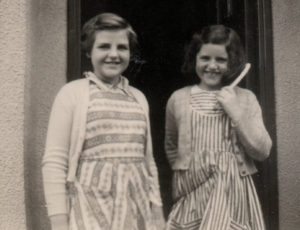 Growing up: our daughters – Shirley and Sandra
Growing up: our daughters – Shirley and Sandra
The village shop was still at number one Rose Terrace with Mrs Trebilcock as its proprietor. It still sold a wide range of everyday family requirements but not bread or fresh meat which was delivered. A baker’s van called three times a week, two butchers came four times a week and groceries could be ordered and delivered to our doors. Mrs Roberts, who had lived at number five Rose Terrace, had been licenced to sell cigarettes and tobacco but she had died and those who smoked had to buy their cigarettes and tobacco from the garage shop. Collett and Seymour and David Tiddy continued to visit the village on a regular basis during the 1960s to sell clothes but, with large retail stores being developed in Truro and Newquay, their services soon became redundant and they stopped calling by the end of the decade.
A village seat was positioned by Mr Parkins repair shop, where the bus stopped on its journey to Newquay. Buses from Newquay to Truro stopped opposite, by Raleigh House.
Mitchell was said to have had a ghost, a girl in Victorian dress. She was last seen in the summer of 1965 by a lady, Mrs Elizabeth Bain from Plymouth.
New families were moving to the village: Ivy House and Wellesley House had new occupants and there were several changes to those living in Chapel Terrace. The families who lived there when I was a boy had all gone and others had moved in, some of them had moved on again. Fair Park View council houses saw many families leaving and many others moving to there and even Mitchell School was converted into a dwelling.
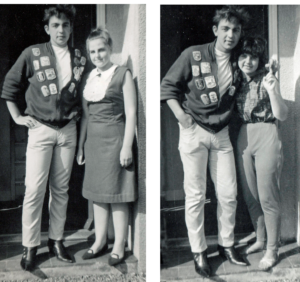 All grown up: Boy Les with his sisters – Shirley and Sandra
All grown up: Boy Les with his sisters – Shirley and Sandra
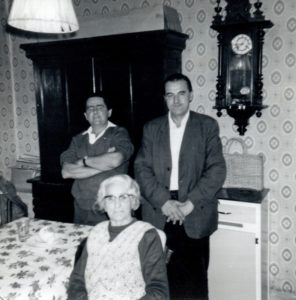 Circa 1975: me, my brother Bill, and our mother, Mabel at number two Rose Terrace
Circa 1975: me, my brother Bill, and our mother, Mabel at number two Rose Terrace
Mitchell Chapel remained as the centre of many of the village activities; the large meeting room there continued to be frequently used. It was the meeting place for the Mitchell Women’s Institute which had its first meeting on the 20th January 1953 but had closed in the 1990s due to falling membership. The Methodist chapel still held regular Sunday services and each spring it was beautifully decorated with flowers for the flower festival. The chapel was full for the annual harvest festival celebrations and in the late 1950s and early 1960s the meeting room provided a venue for the youth club, children’s parties, carnivals and all sorts of celebrations.
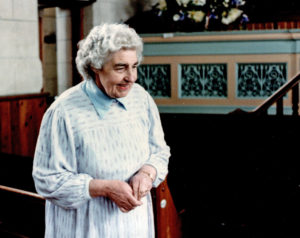 Doreen (D) Donnithorne (my wife) on flower duty in the chapel
Doreen (D) Donnithorne (my wife) on flower duty in the chapel
It was a beautiful chapel which was always kept very clean. I am sure my daughter, Shirley, was the last person to be married there, in 1978, and my granddaughters, Lorna Jane and Kirsty, were the last to be christened there. It was the centre of community life until recent times but the last service was held in the 1980s. It closed because it did not have a sufficient congregation to support it. The inside of the building was completely gutted and it was redeveloped for residential use.
In 1977, Mitchell celebrated the Queen’s Silver jubilee in great style: the children took part in a fancy-dress competition and a football match was organised between Mitchell’s men’s and ladies’ football teams. The men wore dresses and the ladies donned the men’s football strips. I cannot remember the outcome but it was a great day. Another village celebration was organised for the royal wedding in 1981.
A market gardener, Mr Best, established a strawberry farm on the south side of the road to Summercourt and people came from miles around to pick strawberries in the summer months.
1990 to 2010
The Pillars Hotel and Restaurant continued to offer its services and being on the main A30 road, it was never short of customers. It changed hands several times before becoming a family home. In the early 1990s, there was a problem with the front wall when the stonework/cob started to deteriorate.
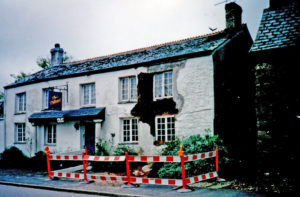 The Pillars Hotel when a part of the front wall collapsed.
The Pillars Hotel when a part of the front wall collapsed.
The Bypass
A huge change came to the village in the early 1990s. Following the war years there had been an ever-increasing amount of traffic on the main A30 road through Mitchell: sometimes it was at a standstill, back towards Summercourt and the opposite way up Carland Hill. There were several serious and sometimes fatal accidents. More than once the entrance of the pub was damaged and on one occasion a car mounted the pavement outside our house, number two Rose Terrace, breaking the granite gate post. On the road towards Summercourt, there was a very bad corner, near Acre’n or Edgern Pool, where several people were killed. Plans for a bypass were being considered by the Highways Department and details of these were being displayed and discussed throughout the village.
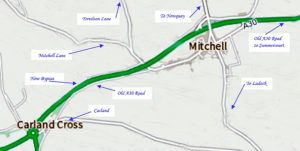
Most of the villagers looked forward to the completion of the bypass and when it was opened in the early 1990s they held a day of celebration. There was delight that vehicles no longer streamed through the village but there was a down-side, because the traffic had moved to the bypass, the road through the village had become a carpark with cars parked nose to tail. Ironically, too, the bypass often became so busy that it seemed that the traffic problem had simply been transferred from the old to the new main road.
Then the developers moved in! Initially, 40 new houses were built in the area which included Archie Hoskin’s Yard, a number of barn conversions were carried out and some of the older buildings were given a face lift. John Parkins’ old office building at the entrance to the yard was partially demolished and rebuilt and the land around the old coal yard and out to the edge of the bypass became a new housing development named Hawkin’s Place. The piece of land at the end of the terraced houses, opposite the Pillars, and where the road to Newquay began, was developed and called St Francis Meadow. Any piece of land that fell within the village boundary was being infilled with houses and the population of Mitchell must have nearly trebled. Additionally, as the recent developments did not have sufficient parking spaces or garages, the problem of vehicle congestion in the village became even worse.
Alas, these recent developments had taken away the final vestiges of the place in which I had grown up. Village life, for me and my family, and many other families, would never be the same.
One good outcome, however, was the opportunity to build a children’s play park. A village committee was formed in 1995 to lead on this but first they had to find somewhere suitable. The committee secured a grant from the Millennium Fund and the play area was constructed next to Ivy House, in the small field below the old farm orchard. Many people including John Sweet and I helped with the work. I was a bit younger then and could still swing a pick and shovel.
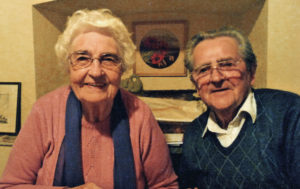 Les and D
Les and D
A few years ago, I think it was about 2006, the first village fun day was held. It reminded me of past carnival days and other celebrations the village had held over the years: it was good to see everyone organising and enjoying these events. It is good, too, that in 2011, Mitchell entered the South-West in Bloom competition.
Mitchell is still changing. We have many new families living here and hopefully they will breathe new life into the village. I sit on the wall outside the house and pass the time of day with many of the people who have come here to live although I do not always know their names. I have seen their families arrive, their children grow up and go out to work and perhaps one day, just like me, they will sit and reflect on their early years and of growing up in Mitchell. It is now 2011 and time to close these recollections of my life in Mitchell.
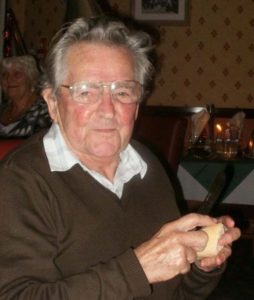 Lesley Donnithorne (17th March 1926 – 25th January 2021)
Lesley Donnithorne (17th March 1926 – 25th January 2021)
Les’s eulogy was delivered at his funeral by his son, Boy Les, who finished with the words:
“A loving husband, father, grandfather and great grandfather – ‘Stand Easy’ Old Soldier”
It is usual to include here some information about the author but having read this article you will appreciate that there is little more to add. Suffice to say that Les was a proud Mitchell man and a proud man of Cornwall.
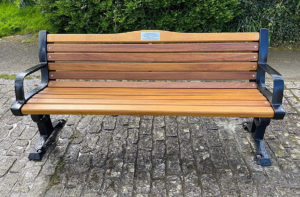 Les’s commemoration seat 2022
Les’s commemoration seat 2022


Great stuff from Les a true character and Mitchellite, thanks for the memories R.I.P. Les.
6j2qa6
A wonderful storyteller! For over 40 years, I have travelled to Mitchell to catch up with Les and Doreen, Les was my father’s first cousin. They and Les (boy Les) are the last link to my grandfather, Arthur Tozer. I love listening to their stories of my family, keeping the link alive between Cornwall and northern NSW, and our family village, Crantock and Elsmore. I was in Mitchell, the day Les received his American passport. He was so proud to be part American but he was the epitome of a Cornish gentleman. I will be back in 2023! I can’t wait to catch up with Doreen and the rest of the Donnithorne. RIP Les, you are greatly loved and sorely missed. Love always, cousin Carolyn ❤️
What a wonderful history of life in the village it captures the true evolution of small village life through the twentieth and into the twenty first centuries which must be one of the fastest changes to the life of a village for many centuries
It was so very well told
Thank you Joseph, it was a pleasure to work with Boy Les to publish his father’s memories.
That was a wonderful read, no one else would have been able to complete it. Mum and Dad loved both Doreen and Les, I miss not being in the village
Rest In Peace Les, until we meet again,
Mike
Being an old Truro Boy born and raised in Hendra, I feel this is the best account of village life I have ever read. I am aged 87years of age so can recall the times the author describes so well. I would have loved to have known Les and those that he speaks so fondly of. I look back to my life as a boy of Hendra and speak so highly and fondly of those far off times and all the wonderful neighbours and friends that I left behind when I left Truro aged seventeen. Now just memories, but which are still with me. God Bless you Les for helping me recall such wonderful never to forgotten times. Thank you.
What a great read of times we won’t see again..
What a beautiful history to leave for your village. So valuable.
We lived at rose cottage in 1942 I went to school there up the hill and used to watch Mr Ferris the blacksmith who many years became my father in law
I worked at F Davey & sons, Tresillian Barton, Summercourt between 1976 and 1984 as a Storeman. Billy Donnithorne was a mechanic there and was regularly handing out parts to him. He was a really good seasoned mechanic and I got on well with him. I have picture of him driving a digger at Davey’s.
I was born at the old post office in Mitchell in June 1960 to Archie & Doreen Ridley. We moved to Hampshire around 1963. My Dad was taken in by The Philips family who ran the farm at Somerscourt after he was orphaned. He passed over 20 years ago and I’ve always regretted not asking more about his and our life back in Cornwall.
If anyone had any information I’d love to hear about it.